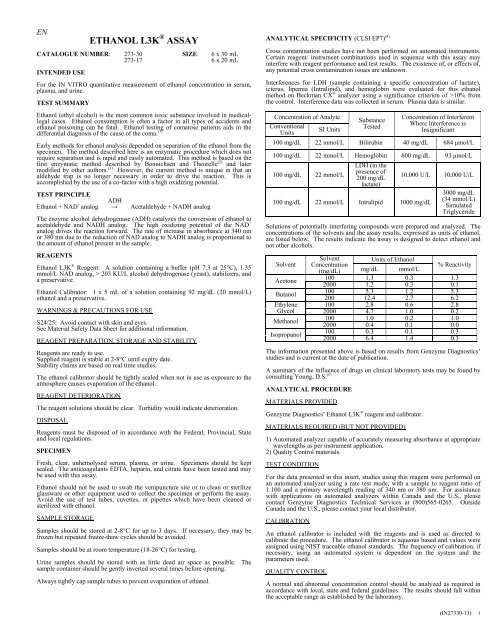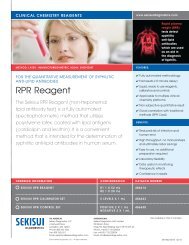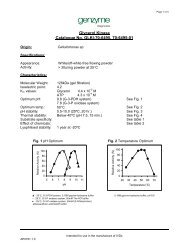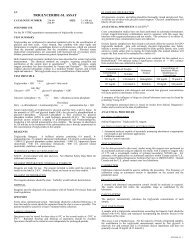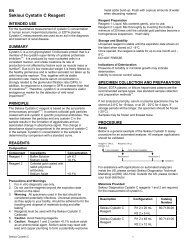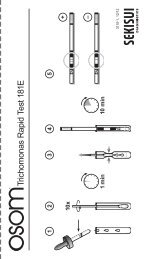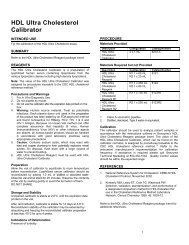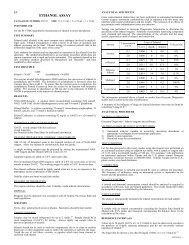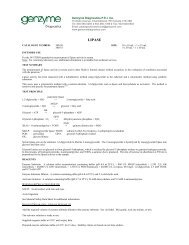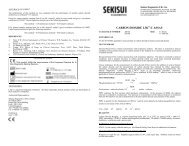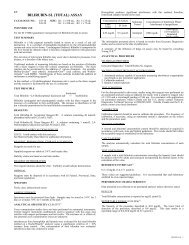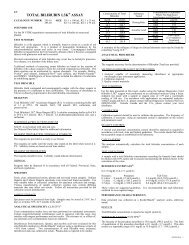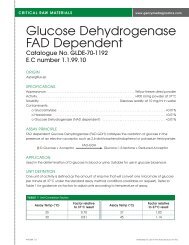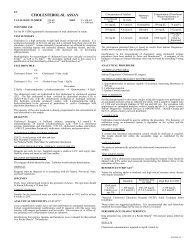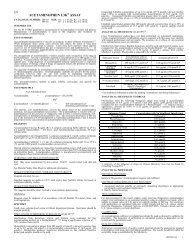ETHANOL L3K® ASSAY - Sekisui Diagnostics
ETHANOL L3K® ASSAY - Sekisui Diagnostics
ETHANOL L3K® ASSAY - Sekisui Diagnostics
You also want an ePaper? Increase the reach of your titles
YUMPU automatically turns print PDFs into web optimized ePapers that Google loves.
EN<br />
<strong>ETHANOL</strong> L3K ® <strong>ASSAY</strong><br />
CATALOGUE NUMBER: 273-30 SIZE: 6 x 30 mL<br />
273-17 6 x 20 mL<br />
INTENDED USE<br />
For the IN VITRO quantitative measurement of ethanol concentration in serum,<br />
plasma, and urine.<br />
TEST SUMMARY<br />
Ethanol (ethyl alcohol) is the most common toxic substance involved in medicallegal<br />
cases. Ethanol consumption is often a factor in all types of accidents and<br />
ethanol poisoning can be fatal. Ethanol testing of comatose patients aids in the<br />
differential diagnosis of the cause of the coma. (1)<br />
Early methods for ethanol analysis depended on separation of the ethanol from the<br />
specimen. The method described here is an enzymatic procedure which does not<br />
require separation and is rapid and easily automated. This method is based on the<br />
first enzymatic method described by Bonnichsen and Theorelle (2) and later<br />
modified by other authors. (3) However, the current method is unique in that an<br />
aldehyde trap is no longer necessary in order to drive the reaction. This is<br />
accomplished by the use of a co-factor with a high oxidizing potential.<br />
TEST PRINCIPLE<br />
ADH<br />
Ethanol + NAD + analog → Acetaldehyde + NADH analog<br />
The enzyme alcohol dehydrogenase (ADH) catalyzes the conversion of ethanol to<br />
acetaldehyde and NADH analog. The high oxidizing potential of the NAD +<br />
analog drives the reaction forward. The rate of increase in absorbance at 340 nm<br />
or 380 nm due to the reduction of NAD analog to NADH analog is proportional to<br />
the amount of ethanol present in the sample.<br />
REAGENTS<br />
Ethanol L3K ® Reagent: A solution containing a buffer (pH 7.3 at 25°C), 1.35<br />
mmol/L NAD analog, > 203 KU/L alcohol dehydrogenase (yeast), stabilizers, and<br />
a preservative.<br />
Ethanol Calibrator: 1 x 5 mL of a solution containing 92 mg/dL (20 mmol/L)<br />
ethanol and a preservative.<br />
WARNINGS & PRECAUTIONS FOR USE<br />
S24/25: Avoid contact with skin and eyes.<br />
See Material Safety Data Sheet for additional information.<br />
REAGENT PREPARATION, STORAGE AND STABILITY<br />
Reagents are ready to use.<br />
Supplied reagent is stable at 2-8°C until expiry date.<br />
Stability claims are based on real time studies.<br />
The ethanol calibrator should be tightly sealed when not in use as exposure to the<br />
atmosphere causes evaporation of the ethanol.<br />
REAGENT DETERIORATION<br />
The reagent solutions should be clear. Turbidity would indicate deterioration.<br />
DISPOSAL<br />
Reagents must be disposed of in accordance with the Federal, Provincial, State<br />
and local regulations.<br />
SPECIMEN<br />
Fresh, clear, unhemolysed serum, plasma, or urine. Specimens should be kept<br />
sealed. The anticoagulants EDTA, heparin, and citrate have been tested and may<br />
be used with this assay.<br />
Ethanol should not be used to swab the venipuncture site or to clean or sterilize<br />
glassware or other equipment used to collect the specimen or perform the assay.<br />
Avoid the use of test tubes, cuvettes, or pipettes which have been cleaned or<br />
sterilized with ethanol.<br />
SAMPLE STORAGE<br />
Samples should be stored at 2-8°C for up to 3 days. If necessary, they may be<br />
frozen but repeated freeze-thaw cycles should be avoided.<br />
Samples should be at room temperature (18-26°C) for testing.<br />
Urine samples should be stored with as little dead air space as possible. The<br />
sample container should be gently inverted several times before opening.<br />
Always tightly cap sample tubes to prevent evaporation of ethanol.<br />
ANALYTICAL SPECIFICITY (CLSI EP7) (4)<br />
Cross contamination studies have not been performed on automated instruments.<br />
Certain reagent/ instrument combinations used in sequence with this assay may<br />
interfere with reagent performance and test results. The existence of, or effects of,<br />
any potential cross contamination issues are unknown.<br />
Interferences for LDH (sample containing a specific concentration of lactate),<br />
icterus, lipemia (Intralipid), and hemoglobin were evaluated for this ethanol<br />
method on Beckman CX ® analyzer using a significance criterion of >10% from<br />
the control. Interference data was collected in serum. Plasma data is similar.<br />
Concentration of Analyte<br />
Conventional<br />
Units<br />
SI Units<br />
Substance<br />
Tested<br />
Concentration of Interferent<br />
Where Interference is<br />
Insignificant<br />
100 mg/dL 22 mmol/L Bilirubin 40 mg/dL 684 μmol/L<br />
100 mg/dL 22 mmol/L Hemoglobin 600 mg/dL 93 μmol/L<br />
100 mg/dL 22 mmol/L<br />
LDH (in the<br />
presence of<br />
200 mg/dL<br />
lactate)<br />
100 mg/dL 22 mmol/L Intralipid 1000 mg/dL<br />
10,000 U/L 10,000 U/L<br />
3000 mg/dL<br />
(34 mmol/L)<br />
Simulated<br />
Triglyceride<br />
Solutions of potentially interfering compounds were prepared and analyzed. The<br />
concentrations of the solvents and the assay results, expressed as units of ethanol,<br />
are listed below. The results indicate the assay is designed to detect ethanol and<br />
not other alcohols.<br />
Solvent<br />
Solvent Units of Ethanol<br />
Concentration<br />
(mg/dL) mg/dL mmol/L<br />
% Reactivity<br />
Acetone<br />
100 1.3 0.3 1.3<br />
2000 1.2 0.3 0.1<br />
Butanol<br />
100 5.3 1.2 5.3<br />
200 12.4 2.7 6.2<br />
Ethylene 100 2.8 0.6 2.8<br />
Glycol 2000 4.7 1.0 0.2<br />
Methanol<br />
100 1.0 0.2 1.0<br />
2000 0.4 0.1 0.0<br />
Isopropanol<br />
100 0.3 0.1 0.3<br />
2000 6.4 1.4 0.3<br />
The information presented above is based on results from Genzyme <strong>Diagnostics</strong>’<br />
studies and is current at the date of publication.<br />
A summary of the influence of drugs on clinical laboratory tests may be found by<br />
consulting Young, D.S. (5)<br />
ANALYTICAL PROCEDURE<br />
MATERIALS PROVIDED<br />
Genzyme <strong>Diagnostics</strong>’ Ethanol L3K ® reagent and calibrator.<br />
MATERIALS REQUIRED (BUT NOT PROVIDED)<br />
1) Automated analyzer capable of accurately measuring absorbance at appropriate<br />
wavelengths as per instrument application.<br />
2) Quality Control materials.<br />
TEST CONDITION<br />
For the data presented in this insert, studies using this reagent were performed on<br />
an automated analyzer using a rate test mode, with a sample to reagent ratio of<br />
1:100 and a primary wavelength reading of 340 nm or 380 nm. For assistance<br />
with applications on automated analyzers within Canada and the U.S., please<br />
contact Genzyme <strong>Diagnostics</strong> Technical Services at (800)565-0265. Outside<br />
Canada and the U.S., please contact your local distributor.<br />
CALIBRATION<br />
An ethanol calibrator is included with the reagents and is used as directed to<br />
calibrate the procedure. The ethanol calibrator is aqueous based and values were<br />
assigned using NIST traceable ethanol standards. The frequency of calibration, if<br />
necessary, using an automated system is dependent on the system and the<br />
parameters used.<br />
QUALITY CONTROL<br />
A normal and abnormal concentration control should be analyzed as required in<br />
accordance with local, state and federal guidelines. The results should fall within<br />
the acceptable range as established by the laboratory.<br />
(IN27330-13) 1
CALCULATIONS<br />
The analyzer automatically calculates the ethanol concentration of each sample.<br />
TEST LIMITATIONS<br />
A sample with an ethanol concentration exceeding the linearity limit should be<br />
diluted with 0.9% saline and reassayed incorporating the dilution factor in the<br />
calculation of the value.<br />
REFERENCE INTERVALS<br />
The legal plasma or serum limit for drivers is less than 78 mg/dL (17 mmol/L)<br />
(Canada) (6) .<br />
PERFORMANCE CHARACTERISTICS<br />
Data presented was collected on a Beckman CX ® analyzer unless otherwise stated.<br />
RESULTS<br />
Ethanol concentration is expressed as mg/dL (mmol/L).<br />
REPORTABLE RANGE (CLSI EP6) (4)<br />
The linearity of the procedure is 600 mg/dL (130.3 mmol/L). The lower limit of<br />
detection of the procedure described is 10 mg/dL (2.2 mmol/L). This data results<br />
in a reportable range of 10-600 mg/dL (2.2 to 130.3 mmol/L).<br />
PRECISION STUDIES (CLSI EP5) (4)<br />
Total precision was collected on three concentrations of control materials in forty<br />
runs conducted over twenty days.<br />
Concentration Total SD Total Concentration Within Run SD<br />
mg/dL mmol/L mg/dL mmol/L<br />
CV%<br />
mg/dL mmol/L mg/dL mmol/L<br />
Within<br />
Run<br />
CV%<br />
40.3 8.8 1.8 0.4 4.6 41.5 9.0 1.4 0.3 3.4<br />
98.1 21.1 2.6 0.6 2.6 97.6 21.2 1.4 0.3 1.5<br />
245.1 53.3 6.1 1.3 2.5 240.0 52.1 2.4 0.5 1.0<br />
Within run precision data was collected on three concentrations of control<br />
materials; each control material was run twenty times in a single assay.<br />
ACCURACY (CLSI EP9) (4)<br />
The performance of this method (y) was compared with the performance of<br />
another rate ethanol method (x) on a Beckman CX ® . Forty patient serum samples<br />
ranging from 22.5 to 651.9 mg/dL (4.9 to 141.5 mmol/L) gave a correlation<br />
coefficient of 0.9994. Linear regression analysis gave the following equation:<br />
This method = 1.06 (reference method) – 2.45 mg/dL (0.5 mmol/L).<br />
The performance of this method (y) was compared with the performance of<br />
another rate ethanol method (x) on a Beckman CX ® . Forty patient plasma samples<br />
ranging from 17.3 to 580.8 mg/dL (3.8 to 125.9 mmol/L) gave a correlation<br />
coefficient of 0.9994. Linear regression analysis gave the following equation:<br />
This method = 1.03 (reference method) – 5.86 mg/dL (1.3 mmol/L).<br />
The performance of this method (y) was compared with the performance of<br />
another rate ethanol method (x) on a Beckman CX ® . Forty patient urine samples<br />
ranging from 17.6 to 583.4 mg/dL (3.8 to 126.6 mmol/L) gave a correlation<br />
coefficient of 0.9998. Linear regression analysis gave the following equation:<br />
This method = 1.01 (reference method) + 0.59 mg/dL (0.13 mmol/L).<br />
The information presented above is based on results from Genzyme <strong>Diagnostics</strong><br />
P.E.I. Inc. studies and is current at the date of publication.<br />
TRADEMARKS<br />
L3K is a registered trademark of Genzyme. All other trademarks, brands, product<br />
names and trade names are the property of their respective companies.<br />
Manufactured by:<br />
The Americas<br />
International<br />
Genzyme <strong>Diagnostics</strong> P.E.I. Inc. Genzyme <strong>Diagnostics</strong><br />
70 Watts Avenue 50 Gibson Drive<br />
Charlottetown, PE C1E 2B9<br />
Kings Hill, West Malling<br />
Canada<br />
KENT, ME19 4AF, UK<br />
Phone: 800-565-0265<br />
Email: ukdiagcustomerservice<br />
Fax: 902-628-6504<br />
@genzyme.com<br />
Email: customerservice@genzyme.com<br />
peidiagnostictechnical@genzyme.com<br />
www.genzymediagnostics.com<br />
FR<br />
DOSAGE BIOLOGIQUE <strong>ETHANOL</strong> L3K<br />
®<br />
NUMÉRO DE CATALOGUE: 273-30 TAILLE: 6 x 30 ml<br />
273-17 6 x 20 mL<br />
UTILISATION PRÉVUE<br />
Pour la mesure quantitative IN VITRO de la concentration d’éthanol dans le<br />
sérum, le plasma et l’urine.<br />
RÉSUMÉ DES TESTS<br />
L'éthanol (alcool éthylique) est la substance commune la plus toxique concernée<br />
dans les litiges médicaux-légaux. La consommation d'éthanol est un facteur<br />
fréquent dans tous les types d'accidents et l'intoxication à l'éthanol peut se révéler<br />
fatale. Les essais portant sur l'éthanol chez les patients comateux facilitent le<br />
diagnostic différentiel quant à la cause du coma. (1)<br />
Les anciennes méthodes pour l'analyse de l'éthanol dépendaient de la séparation de<br />
l'éthanol du spécimen. La méthode décrite dans les présentes est une procédure<br />
enzymatique qui ne requiert pas la séparation et qui est rapidement et facilement<br />
automatisée. Cette méthode est fondée sur la première méthode enzymatique<br />
décrite par Bonnichsen et Theorelle (2) et modifiée par la suite par les autres<br />
auteurs. (3) Cependant, la méthode actuelle est unique en ce sens que la captation de<br />
l'aldéhyde n'est plus nécessaire pour provoquer la réaction chimique. Cela est<br />
accompli grâce à l'utilisation d'un cofacteur doté d'un pouvoir oxydant.<br />
PRINCIPE DU TEST<br />
ADH<br />
Éthanol + analogue de NAD + → acétaldéhyde + analogue de NADH<br />
L'enzyme de l'alcool déshydrogénase (ADH) catalyse la conversion de l'éthanol en<br />
acétaldéhyde et en un analogue de NADH. Le pouvoir oxydant élevé de l'analogue<br />
de NAD + déplace la réaction vers la droite. Le taux d'augmentation de l'absorbance<br />
à 340 nm ou à 380 nm attribuable à la réduction de l'analogue de NAD vers<br />
l'analogue de NADH est proportionnel à la quantité d'éthanol présente dans<br />
l'échantillon.<br />
RÉACTIFS<br />
Réactif à l'éthanol Ethanol L3K ® : Une solution contenant une solution tampon<br />
(pH de 7,3 à 25 °C), un analogue de NAD à 1,35 mmol/L, plus de 203 KU/L<br />
d'alcool déshydrogénase (levure), des agents stabilisants et un agent de<br />
conservation.<br />
Calibrateur d'éthanol : 1 x 5 mL d'une solution contenant 20 mmol/L (92 mg/dL)<br />
d'éthanol et un agent de conservation.<br />
AVERTISSEMENTS ET PRÉCAUTIONS RELATIVES À L'UTILISATION<br />
S24/25 : évitez le contact avec la peau et les yeux.<br />
Voir la fiche signalétique pour des informations complémentaires.<br />
PRÉPARATION, CONSERVATION ET STABILITÉ DU RÉACTIF<br />
Les réactifs sont prêts à être utilisés. Le réactif fourni est stable entre 2 et 8 °C<br />
jusqu'à la date de péremption. Les énoncés relatifs à la stabilité sont fondés sur des<br />
études en temps réel.<br />
Le calibrateur d'éthanol doit être scellé hermétiquement lorsqu'il n'est pas utilisé<br />
car l'exposition à l'air ambiant peut provoquer son évaporation sous forme<br />
d'éthanol.<br />
DÉTÉRIORATION DU RÉACTIF<br />
Les solutions de réactif doivent être transparentes. La turbidité serait dans ce cas le<br />
signe d'une détérioration.<br />
ÉLIMINATION<br />
Les réactifs doivent être éliminés conformément à la réglementation locale,<br />
fédérale, provinciale et de l'État.<br />
SPÉCIMEN<br />
Le sérum qui n'a pas subi d'hémolyse, l'urine ou le plasma à l'état frais et<br />
transparent sont des spécimens de prédilection. Les spécimens doivent être<br />
conservés à l'état scellé. Les anticoagulants EDTA, l'héparine et le citrate ont fait<br />
l'objet de tests et peuvent être utilisés dans le cadre du présent dosage biologique.<br />
L'éthanol ne devrait pas être utilisé pour écouvillonner le site de veinopuncture ou<br />
pour nettoyer ou stériliser les articles de verrerie ou d'autres équipements dont on<br />
se sert pour recueillir les spécimens ou effectuer le dosage biologique. Évitez<br />
d'utiliser les tubes à essais, les cuvettes ou les pipettes qui ont été nettoyés ou<br />
stérilisés avec de l'éthanol.<br />
CONSERVATION DE L'ÉCHANTILLON<br />
Les échantillons doivent être conservés entre 2 et 8 °C pendant trois jours<br />
maximum. Ils peuvent être congelés au besoin, mais il faut éviter les cycles de gel<br />
et de dégel à répétition.<br />
Les échantillons doivent être à température ambiante (entre 18 et 26 °C) pour<br />
servir aux tests.<br />
(IN27330-13) 2
Les échantillons d'urine doivent être conservés dans un espace sans circulation<br />
d'air aussi minimale que possible. Le contenant de l'échantillon doit être retourné à<br />
l'envers et à l'endroit délicatement plusieurs fois avant d'être ouvert.<br />
Fermez toujours hermétiquement l'échantillon avec un capuchon afin de prévenir<br />
l'évaporation de l'éthanol.<br />
SPÉCIFICITÉ ANALYTIQUE (CLSI EP7) (4)<br />
Aucune étude de contamination croisée n'a été effectuée sur les instruments<br />
automatisés. Certaines combinaisons de réactifs ou d'instruments utilisés en<br />
séquence dans le cadre du présent dosage biologique peuvent influer sur le<br />
comportement du réactif et les résultats des tests. Les problèmes liés à une<br />
quelconque contamination croisée ou à ses effets ne sont pas connus.<br />
Les interférences avec la LDH (échantillon contenant une concentration spécifique<br />
de lactate), l'ictère, l'hyperlipidémie (Intralipid) et l'hémoglobine ont été évaluées<br />
relativement à cette méthode à l'éthanol sur l'analyseur Beckman CX ® en faisant<br />
appel à un critère d'importance supérieur à 10 % du matériel de contrôle. Les<br />
données relatives à l'interférence ont été recueillies grâce au sérum. Les données<br />
obtenues avec le plasma sont similaires.<br />
Concentration de la substance<br />
à analyser<br />
Unités<br />
conventionnelles<br />
Unités SI<br />
Substance<br />
testée<br />
Concentration de la<br />
substance interférente<br />
lorsque l'interférence est<br />
négligeable<br />
100 mg/dL 22 mmol/L Bilirubine 40 mg/dL 684 μmol/L<br />
100 mg/dL 22 mmol/L Hémoglobine 600 mg/dL 93 μmol/L<br />
LDH (en<br />
100 mg/dL 22 mmol/L<br />
présence de 10, 000<br />
200 mg/dL de U/L<br />
lactate)<br />
10 000 U/L<br />
100 mg/dL 22 mmol/L Intralipid<br />
1000<br />
mg/dL<br />
3 000 mg/dL<br />
(34 mmol/L)<br />
triglycérides<br />
simulés<br />
Les solutions des composés susceptibles d'interférer les uns avec les autres ont été<br />
préparées et analysées. Les concentrations des solvants et les résultats du dosage<br />
biologique, exprimés en termes d'unités d'éthanol, figurent dans la liste ci-dessous.<br />
Les résultats indiquent que le dosage est conçu pour déceler la présence d'éthanol,<br />
mais pas les autres alcools.<br />
Solvant<br />
Acétone<br />
Butanol<br />
Éthane-1,2-diol<br />
Méthanol<br />
Isopropanol<br />
Concentration de Unités d'éthanol % de<br />
solvant (mg/dL) mg/dL mmol/L réactivité<br />
100 1,3 0,3 1,3<br />
2 000 1,2 0,3 0,1<br />
100 5,3 1,2 5,3<br />
200 12,4 2,7 6,2<br />
100 2,8 0,6 2,8<br />
2 000 4,7 1,0 0,2<br />
100 1,0 0,2 1,0<br />
2 000 0,4 0,1 0,0<br />
100 0,3 0,1 0.3<br />
2 000 6,4 1,4 0,3<br />
L'information susmentionnée est fondée sur les résultats obtenus des études de<br />
Genzyme <strong>Diagnostics</strong> et elle est à jour à la date de la publication.<br />
Un résumé de l'influence des médicaments sur les tests de laboratoire clinique est<br />
disponible sur consultation de Young, D.S. (5)<br />
PROCÉDURE ANALYTIQUE<br />
MATÉRIEL FOURNI<br />
Calibrateur d'éthanol et Réactif à l'éthanol Ethanol L3K ® de Genzyme <strong>Diagnostics</strong><br />
MATÉRIEL REQUIS (MAIS NON FOURNI)<br />
1) Analyseur automatisé capable de mesurer précisément l’absorbance à des<br />
longueurs d’onde appropriées, selon l’application de l’instrument.<br />
2) Matériel de contrôle de qualité.<br />
CONDITIONS DU TEST<br />
Concernant les données présentées dans cet encart, les études ayant fait appel à ce<br />
réactif ont été effectuées sur un analyseur automatisé à l'aide d'un mode d'essai,<br />
avec un échantillon de réactif dont le rapport est de 1:100 et une lecture de la<br />
longueur d'onde primaire de 340 nm ou de 380 nm. Pour obtenir de l'aide sur<br />
l'utilisation des analyseurs automatiques au Canada et aux États-Unis, veuillez<br />
contacter les services techniques de Genzyme <strong>Diagnostics</strong> au 1-800-565-0265. À<br />
l'extérieur du Canada et des États-Unis, contactez votre distributeur local.<br />
CALIBRAGE<br />
Un calibrateur d'éthanol est compris avec les réactifs et il est utilisé tel que prescrit<br />
par les directives afin de calibrer la procédure. Le calibrateur d'éthanol est<br />
compatible avec les composés aqueux et les valeurs ont été attribuées selon les<br />
normes du NIST relatives à la détermination de la présence d'éthanol. La<br />
fréquence du calibrage, au besoin, effectué à l’aide d’un système automatisé<br />
dépend du système et des paramètres utilisés.<br />
CONTROLE DE LA QUALITE<br />
Des contrôles à la concentration normale et à la concentration anormale doivent être<br />
analysés conformément aux directives locales, provinciales/d’État et fédérales. Les<br />
résultats doivent se situer dans un intervalle acceptable à déterminer par le<br />
laboratoire.<br />
CALCULS<br />
L'analyseur calcule automatiquement la concentration d'éthanol de chaque<br />
échantillon.<br />
LIMITES DES TESTS<br />
Un échantillon dont la concentration en éthanol dépasse la limite de linéarité<br />
devrait être dilué dans une solution saline à 0,9 % et faire l'objet d'un autre dosage<br />
qui intègre le facteur de dilution dans le calcul de la valeur.<br />
INTERVALLES DE RÉFÉRENCE<br />
La limite légale mesurée à partir du plasma ou du sérum est inférieure à 78 mg/dL<br />
(17 mmol/L) (Canada) (6) .<br />
CARACTÉRISTIQUES LIÉES AU COMPORTEMENT<br />
Les données présentées ont été recueillies sur un analyseur Beckman CX ® sauf<br />
mention contraire.<br />
RÉSULTATS<br />
La concentration d'éthanol est exprimée en mg/dL (mmol/L).<br />
INTERVALLE A SIGNALER (CLSI EP6) (4)<br />
La linéarité de la procédure est de 600 mg/dL (130,3 mmol/L). La limite inférieure<br />
de détection pour la procédure décrite est de 10 mg/dL (2,2 mmol/L). Ces données<br />
se situent dans un intervalle de signalement variant entre 10 et 600 mg/dL (2,2 et<br />
130,3 mmol/L).<br />
ÉTUDES DE PRECISION (CLSI EP5) (4)<br />
Une précision totale a été obtenue avec trois concentrations du matériel de<br />
contrôle à quarante reprises pendant vingt jours.<br />
Concentration Écart-type total % Concentration<br />
Écart-type dans<br />
le groupe<br />
% CV<br />
CV<br />
dans le<br />
total<br />
mg/dL mmol/L mg/dL mmol/L<br />
mg/dL mmol/L mg/dL mmol/L<br />
groupe<br />
40,3 8,8 1,8 0,4 4,6 41,5 9,0 1,4 0,3 3,4<br />
98,1 21,1 2,6 0,6 2,6 97,6 21,2 1,4 0,3 1,5<br />
245,1 53,3 6,1 1,3 2,5 240,0 52,1 2,4 0,5 1,0<br />
Les données précises obtenues dans un groupe proviennent de matériel de contrôle<br />
testé selon trois concentrations, chaque groupe étant testé vingt fois dans le cadre<br />
d'un dosage biologique unique.<br />
EXACTITUDE (CLSI EP9) (4)<br />
Le comportement de cette méthode (y) a été comparé avec celui d'une autre<br />
méthode (x) mesurant le taux d'éthanol sur un Beckman CX ® . Les échantillons<br />
provenant de quarante patients dont la teneur en éthanol dans le sérum variait<br />
entre 22,5 et 651,9 mg/dL (4,9 et 141,5 mmol/L) ont donné un coefficient de<br />
corrélation égal à 0,9994. L'équation suivante a été obtenue à l'issue de l'analyse<br />
de régression linéaire :<br />
Cette méthode = 1,06 (méthode de référence) – 2,45 mg/dL (0,5 mmol/L).<br />
Le comportement de cette méthode (y) a été comparé avec celui d'une autre<br />
méthode (x) mesurant le taux d'éthanol sur un Beckman CX ® . Les échantillons<br />
provenant de quarante patients dont la teneur en éthanol dans le plasma variait<br />
entre 17,3 et 580,8 mg/dL (3,8 et 126,9 mmol/L) ont donné un coefficient de<br />
corrélation égal à 0,9994. L'équation suivante a été obtenue à l'issue de l'analyse<br />
de régression linéaire :<br />
Cette méthode = 1,03 (méthode de référence) – 5,86 mg/dL (1,3 mmol/L).<br />
Le comportement de cette méthode (y) a été comparé avec celui d'une autre<br />
méthode (x) mesurant le taux d'éthanol sur un Beckman CX ® . Les échantillons<br />
provenant de quarante patients dont la teneur en éthanol dans l'urine variait entre<br />
17,6 et 583,4 mg/dL (3,8 et 126,6 mmol/L) ont donné un coefficient de corrélation<br />
égal à 0,9998. L'équation suivante a été obtenue à l'issue de l'analyse de régression<br />
linéaire :<br />
Cette méthode = 1,01 (méthode de référence) + 0,59 mg/dL (0,13 mmol/L).<br />
L'information susmentionnée est fondée sur les résultats obtenus des études<br />
effectuées par Genzyme <strong>Diagnostics</strong> P.E.I. Inc. et elle est à jour à la date de la<br />
publication.<br />
MARQUES DE COMMERCE<br />
L3K est une marque de commerce déposée de Genzyme. Toutes les autres<br />
marques de commerce, les marques ainsi que tous les noms de produits sont la<br />
propriété de leurs propriétaires respectifs.<br />
Fabriqué par:<br />
Les Amériques<br />
International<br />
Genzyme <strong>Diagnostics</strong> P.E.I. Inc. Genzyme <strong>Diagnostics</strong><br />
70, avenue Watts 50 Gibson Drive<br />
Charlottetown (Île-du-Prince-Édouard) Kings Hill, West Malling<br />
C1E 2B9 Canada<br />
KENT, ME19 4AF, RU<br />
Téléphone: 1-800-565-0265<br />
Télécopieur: 902-628-6504<br />
Courriel: ukdiagcustomerservice<br />
Courriel: customerservice@genzyme.com @genzyme.com<br />
peidiagnostictechnical@genzyme.com<br />
www.genzymediagnostics.com<br />
(IN27330-13) 3
ES<br />
ANÁLISIS DE ETANOL L3K ®<br />
NÚMERO DE CATÁLOGO: 273-30 TAMAÑO: 6 x 30 ml<br />
273-17 6 x 20 ml<br />
USO PARA EL QUE FUE DISEÑADO<br />
Para la medición cuantitativa IN VITRO de concentración de etanol en suero,<br />
plasma y orina.<br />
RESUMEN DEL ANÁLISIS<br />
El etanol (alcohol etílico) es la substancia tóxica que se halla con mayor<br />
frecuencia en los casos de medicina forense. El consumo de etanol es a menudo<br />
un factor determinante en todo tipo de accidente, y el envenenamiento con etanol<br />
puede ser fatal. Los análisis del etanol en pacientes en estado comatoso ayudan en<br />
el diagnóstico diferencial de la causa del coma. (1)<br />
Los métodos usados anteriormente para el análisis del etanol dependían de la<br />
separación del etanol de la muestra. El método de análisis aquí descrito es un<br />
procedimiento enzimático para el que no se necesita la separación, y se puede<br />
automatizar fácil y rápidamente. Este método se funda en el primer método<br />
enzimático descrito por Bonnichsen y Theorelle (2) y que fue modificado<br />
posteriormente por otros autores. (3) Sin embargo, el método actual es único en el<br />
sentido de que ya no se necesita de un separador de aldehído a fin de poner en<br />
marcha la reacción. Esto se logra mediante el empleo de un cofactor de gran<br />
potencial como agente oxidante.<br />
PRINCIPIO DEL ANÁLISIS<br />
ADH<br />
Etanol + NAD + análogo → Acetaldehído + NADH análogo<br />
La enzima alcohol deshidrogenasa (ADH) cataliza la conversión del etanol en<br />
acetaldehído y NADH análogo. El gran potencial como agente oxidante de NAD +<br />
análogo pone en marcha la reacción. El índice de incremento en la absorbencia a<br />
340 nm o a 380 nm, debido a la reducción de NAD análogo a NADH análogo, es<br />
proporcional a la cantidad de etanol presente en la muestra.<br />
AGENTES REACTIVOS<br />
Agente reactivo Etanol L3K ® : Es una solución que contiene un tampón (pH 7.3 a<br />
25°C), NAD analógico de 1.35 mmol/l, alcohol deshidrogenasa (levadura) de ><br />
203 Ku/l, estabilizadores y un conservante.<br />
Calibrador de etanol: 1 x 5 ml de una solución que contiene etanol de 20 mmol/l<br />
(92 mg/dl) y un conservante.<br />
ADVERTENCIAS Y MEDIDAS DE PRECAUCIÓN PARA SU USO<br />
S24/25: Evite el contacto con la piel y los ojos. Para obtener mayor información,<br />
lea la hoja de datos de seguridad de materiales.<br />
PREPARACIÓN, ALMACENAMIENTO Y ESTABILIDAD DEL AGENTE<br />
REACTIVO<br />
Los agentes reactivos vienen listos para su uso. El agente reactivo que se<br />
suministra es estable hasta la fecha de vencimiento, a una temperatura de 2 a 8° C.<br />
Las afirmaciones acerca de la estabilidad se fundan en estudios realizados en<br />
tiempo real.<br />
El calibrador de etanol debe estar herméticamente cerrado cuando no se emplee<br />
pues su exposición a la atmósfera produce la evaporación del etanol.<br />
DETERIORO DEL AGENTE REACTIVO<br />
El agente reactivo debe ser transparente. La turbidez podría ser una indicación de<br />
deterioro.<br />
ELIMINACIÓN<br />
Los agentes reactivos se deben eliminar de acuerdo con las estipulaciones de las<br />
normas federales, provinciales, estatales y locales.<br />
MUESTRA<br />
Las muestras de preferencia son las del suero, plasma u orina recién tomadas,<br />
transparentes, sin hemolizar. Las muestras deben conservarse bien cerradas. Los<br />
anticoagulantes EDTA, la heparina y el citrato han sido analizados y pueden<br />
emplearse en este análisis.<br />
No se debe usar etanol para limpiar el lugar del pinchazo en la vena, ni para<br />
limpiar o esterilizar los utensilios de vidrio ni los equipos para la recolección de<br />
las muestras o para efectuar el análisis. Evite emplear probetas, tubos o pipetas<br />
que hayan sido limpiadas o esterilizadas con etanol.<br />
ALMACENAMIENTO DE LAS MUESTRAS<br />
Las muestras se pueden conservar hasta tres días a una temperatura de entre 2 y 8°<br />
C. Si es necesario, se pueden congelar, pero debe evitarse los ciclos reiterados de<br />
congelamiento-descongelamiento.<br />
Las muestras deben estar a temperatura ambiente (entre 18 y 26°C) para su<br />
análisis.<br />
Las muestras de orina deben guardarse con el mínimo espacio libre que sea<br />
posible. El envase de la muestra debe ser invertido cuidadosamente varias veces<br />
antes de abrirlo.<br />
Siempre tape herméticamente las probetas para evitar la evaporación del etanol.<br />
ESPECIFICIDAD ANALITICA (CLSI EP7) (4)<br />
No se ha realizado estudios de contaminación cruzada en instrumentos<br />
automatizados. Ciertas combinaciones de agentes reactivos / instrumentos<br />
utilizados en secuencia en este estudio pueden interferir el desempeño de los<br />
agentes reactivos y los resultados de los análisis. Se desconoce si existen<br />
problemas de contaminación cruzada posible, o de sus efectos.<br />
Para este método de análisis de etanol, se evaluó la interferencia producida por<br />
LDH (muestra que contiene una concentración de lactato específica), ictericia,<br />
presencia de lípidos en la sangre (Intralípido) y hemoglobina, en un analizador<br />
Beckman CX ® , aplicando un criterio de relevancia de más de un 10% de<br />
desviación de la media de control. Los datos de interferencia se recogieron en<br />
suero. Los datos para el plasma son similares.<br />
Concentración del analizado<br />
Unidades<br />
convencionales<br />
Unidades SI<br />
Substancia<br />
analizada<br />
Concentración de<br />
interferente en casos en<br />
que la interferencia es<br />
insignificante<br />
100 mg/dl 22 mmol/l Bilirubina 40 mg/dl 684 µmol/l<br />
100 mg/dl 22 mmol/l Hemoglobina 600 mg/dl 93 μmol/l<br />
100 mg/dl 22 mmol/l<br />
LDH (en<br />
presencia de 200<br />
mg/dl de lactato)<br />
100 mg/dl 22 mmol/l Intralípido 1000 mg/dl<br />
10,000 u/l 10,000 u/l<br />
3000 mg/dl<br />
(34 mmol/l) de<br />
triglicéridos<br />
simulados<br />
Se prepararon y analizaron soluciones de compuestos que tuvieran el potencial de<br />
producir interferencia. Las concentraciones de disolventes y los resultados de los<br />
análisis expresados como unidades de etanol, se indican a continuación. Los<br />
resultados indican que este análisis ha sido diseñado para detectar etanol y no<br />
otros alcoholes.<br />
Disolvente<br />
Acetona<br />
Butanol<br />
Etilénglicol<br />
Metanol<br />
Isopropanol<br />
Unidades de<br />
etanol<br />
mg/dl mmol/l<br />
100 1.3 0.3 1.3<br />
2000 1.2 0.3 0.1<br />
100 5.3 1.2 5.3<br />
200 12.4 2.7 6.2<br />
100 2.8 0.6 2.8<br />
2000 4.7 1.0 0.2<br />
100 1.0 0.2 1.0<br />
2000 0.4 0.1 0.0<br />
100 0.3 0.1 0.3<br />
2000 6.4 1.4 0.3<br />
Concentración del<br />
disolvente ( en mg/dl)<br />
Reactividad<br />
en %<br />
La información que se presenta arriba se funda en los resultados de los estudios<br />
practicados por Genzyme <strong>Diagnostics</strong>, y está vigente a la fecha de su publicación.<br />
Se puede obtener un resumen de la influencia de los medicamentos en estudios<br />
clínicos de laboratorio consultando a Young, D.S. (5)<br />
PROCEDIMIENTO ANALÍTICO<br />
MATERIALES SUMINISTRADOS<br />
Agente reactivo y calibrador Etanol L3K ® de Genzyme <strong>Diagnostics</strong>.<br />
MATERIALES NECESARIOS (PERO NO SUMINISTRADOS)<br />
1) Analizador automatizado, capaz de medir con precisión la absorbencia a una<br />
longitud de onda adecuada, según la aplicación por instrumento.<br />
2) Materiales de control de calidad.<br />
CONDICIÓN DEL ANÁLISIS<br />
Para la obtención de los datos que se presentan en este encarte, se realizaron<br />
estudios con este agente reactivo en un analizador automatizado en modo de<br />
análisis de índice, con una proporción de 1:100 entre la muestra y el agente<br />
reactivo, y una lectura de longitud de onda primaria de 340 nm o de 380 nm. Si<br />
desea ayuda para aplicaciones en analizadores automatizados en Canadá o EE UU,<br />
comuníquese con Genzyme <strong>Diagnostics</strong> Technical Services llamando al teléfono<br />
(800) 565-0265. En otros países, llame al distribuidor de su localidad.<br />
CALIBRACION<br />
Con los agentes reactivos viene un calibrador de etanol, que se emplea para<br />
calibrar el procedimiento según las indicaciones. El calibrador de etanol es de<br />
base acuosa y los valores se asignaron empleando las normas NIST para el rastreo<br />
del etanol. De ser necesaria, la frecuencia de la calibración utilizando un sistema<br />
automatizado depende del sistema y de los parámetros aplicados.<br />
CONTROL DE CALIDAD<br />
Deben analizarse los controles de concentración normal y anormal, según sea<br />
necesario, de conformidad con las directrices locales, estatales y federales. Los<br />
resultados deben estar dentro de los límites aceptables establecidos por el<br />
laboratorio.<br />
CALCULOS<br />
El analizador calcula automáticamente la concentración de etanol de cada muestra.<br />
(IN27330-13) 4
LIMITACIONES DEL ANALISIS<br />
Debe diluirse con una solución salina al 0.9% y volver a analizarse las muestras<br />
con una concentración de etanol que supere la linealidad, teniendo en cuenta el<br />
factor de dilución en el cálculo del valor.<br />
INTERVALOS DE REFERENCIA<br />
El límite de plasma o de suero establecido por ley para los conductores en de<br />
menos de 78 mg/dl (17 mmol/l) (en Canadá) (6) .<br />
CARACTERÍSTICAS DE LOS RESULTADOS<br />
Los datos presentados fueron recopilados con un analizador Beckman CX ® , salvo<br />
que se indique lo contrario.<br />
RESULTADOS<br />
La concentración de etanol se indica en mg/dl (mmol/l).<br />
REPORTABLE LIMITES (CLSI EP6) (4)<br />
La linealidad del procedimiento es de 600 mg/dl (130.3 mmol/l). El límite inferior<br />
de detección del procedimiento descrito es de 10 mg/dl (2.2 mmol/l). Estos datos<br />
caen dentro de los límites significativos de entre 10 y 600 mg/dl (2.2 y 130.3<br />
mmol/l).<br />
ESTUDIOS DE PRECISION (CLSI EP5) (4)<br />
Los datos de precisión total fueron recopilados en tres concentraciones de<br />
materiales de control en cuarenta pruebas realizadas en un período de veinte días.<br />
Concentración Total de SD Total Concentración<br />
mg/dl mmol/l mg/dl mmol/l<br />
Dentro de la<br />
prueba con SD<br />
de<br />
CV<br />
en % mg/dl mmol/l mg/dl mmol/l<br />
Dentro<br />
de la<br />
prueba<br />
con CV<br />
en %<br />
40.3 8.8 1.8 0.4 4.6 41.5 9.0 1.4 0.3 3.4<br />
98.1 21.1 2.6 0.6 2.6 97.6 21.2 1.4 0.3 1.5<br />
245.1 53.3 6.1 1.3 2.5 240.0 52.1 2.4 0.5 1.0<br />
Los datos de precisión dentro de la prueba fueron recogidos en tres<br />
concentraciones de materiales de control, cada material de control fue sometido a<br />
prueba veinte veces en un solo análisis.<br />
PRECISIÓN (CLSI EP9) (4)<br />
Los resultados de este método (y) se compararon con los de otro método de<br />
análisis de etanol (x), empleando un Beckman CX ® . El análisis de las muestras de<br />
suero de cuarenta pacientes, con límites de entre 22.5 y 651.9 mg/dl (entre 4.9 y<br />
141.5 mmol/l) dio un coeficiente de correlación de 0.9994. El análisis de<br />
regresión lineal dio la siguiente ecuación:<br />
Este método = 1.06 (método de referencia) – 2.45 mg/dl (0.5 mmol/l).<br />
Los resultados de este método (y) se compararon con los de otro método de<br />
análisis de etanol (x), empleando un Beckman CX ® . El análisis de las muestras de<br />
plasma de cuarenta pacientes, con límites de entre 17.3 y 580.8 mg/dl (entre 3.8 y<br />
125.9 mmol/l) dio un coeficiente de correlación de 0.9994. El análisis de<br />
regresión lineal dio la siguiente ecuación:<br />
Este método = 1.03 (método de referencia) – 5.86 mg/dl (1.3 mmol/l).<br />
Los resultados de este método (y) se compararon con los de otro método de<br />
análisis de etanol (x), empleando un Beckman CX ® . El análisis de las muestras de<br />
orina de cuarenta pacientes, con límites de entre 17.6 y 583.4 mg/dl (entre 3.8 y<br />
126.6 mmol/l) dio un coeficiente de correlación de 0.9998. El análisis de<br />
regresión lineal dio la siguiente ecuación:<br />
Este método = 1.01 (método de referencia) + 0.59 mg/dl (0.13 mmol/l).<br />
La información que se presenta arriba se funda en los resultados de los estudios<br />
practicados por Genzyme <strong>Diagnostics</strong> P.E.I. Inc., y está vigente a la fecha de su<br />
publicación.<br />
MARCAS DE COMERCIO<br />
L3K es marca registrada de Genzyme. Todas las demás marcas de fábrica,<br />
marcas, nombres de productos y nombres comerciales son de propiedad de sus<br />
respectivas empresas.<br />
Elaborado por:<br />
Continente<br />
americano<br />
Internacional<br />
Genzyme <strong>Diagnostics</strong> P.E.I. Inc. Genzyme <strong>Diagnostics</strong><br />
70 Watts Avenue 50 Gibson Drive<br />
Charlottetown, PE C1E 2B9<br />
Kings Hill, West Malling<br />
Canada<br />
KENT, ME19 4AF, RU<br />
Teléfono: 800-565-0265<br />
Fax: 902-628-6504 Correo electrónico:<br />
ukdiagcustomerservice<br />
Correo electrónico:<br />
@genzyme.com<br />
customerservice@genzyme.com<br />
peidiagnostictechnical@genzyme.com<br />
www.genzymediagnostics.com<br />
IT<br />
SAGGIO <strong>ETHANOL</strong> L3K ®<br />
NUMERO DI CATALOGO: 273-30 CONFEZIONE: 6 x 30 mL<br />
273-17 6 x 20 mL<br />
DESTINAZIONE D'USO<br />
Per la misura quantitativa IN VITRO della concentrazione di etanolo in siero,<br />
plasma e urine.<br />
RIEPILOGO DEL TEST<br />
L'etanolo (alcool etilico) è la più comune sostanza tossica coinvolta in casi di<br />
medicina legale. Il consumo di etanolo ha spesso un ruolo in incidenti di ogni tipo<br />
e l'avvelenamento da etanolo può essere fatale. L'analisi dell'etanolo in pazienti<br />
comatosi è d'aiuto nella diagnosi differenziale delle cause del coma. (1)<br />
I primi metodi di analisi dell'etanolo dipendevano dalla separazione dell'etanolo<br />
dal campione. Il metodo descritto nel seguito è una procedura enzimatica che non<br />
richiede separazione ed è rapida e facilmente automatizzabile. Il metodo si basa<br />
sul primo metodo enzimatico descritto da Bonnichsen e Theorelle (2) e<br />
successivamente modificato da altri autori. (3) Tuttavia, il metodo in questione è<br />
unico per il fatto che non è più necessaria una trappola per l'aldeide per<br />
promuovere la reazione. Ciò si ottiene tramite l'uso di un cofattore con alto<br />
potenziale ossidante.<br />
PRINCIPIO DEL TEST<br />
ADH<br />
Etanolo + analogo del NAD + → Acetaldeide + analogo del NADH<br />
L'enzima alcol deidrogenasi (ADH) catalizza la conversione dell'etanolo in<br />
acetaldeide e analogo del NADH. La reazione è promossa dall'alto potenziale<br />
ossidante dell'analogo del NAD + . L'aumento dell'assorbanza a 340 nm o 380 nm<br />
causato dalla riduzione dell'analogo del NAD all'analogo del NADH è<br />
proporzionale alla quantità di etanolo presente nel campione.<br />
REAGENTI<br />
Reagente per Etanolo L3K ® : Soluzione contenente un tampone (pH 7.3 a 25°C),<br />
analogo del NAD a 1,35 mmol/L, > 203 KU/L alcol deidrogenasi (lievito),<br />
stabilizzatori e un conservante.<br />
Calibratore per etanolo: 1 x 5 mL di soluzione contenente 20 mmol/L (92 mg/dL)<br />
di etanolo e un conservante.<br />
AVVERTENZE E PRECAUZIONI PER L'USO<br />
S24/25: Evitare il contatto con gli occhi e con la pelle. Consultare la Scheda<br />
Tecnica di Sicurezza dei Materiali per informazioni aggiuntive.<br />
PREPARAZIONE, CONSERVAZIONE E STABILITÀ DEL REAGENTE<br />
I reagenti sono pronti per l'uso. Il reagente fornito è stabile a 2-8°C fino alla data<br />
di scadenza. La stabilità dichiarata si basa su studi in tempo reale.<br />
Il calibratore per l'etanolo dev'essere tenuto chiuso ermeticamente quando non in<br />
uso, dato che l'esposizione all'aria provoca l'evaporazione dell'etanolo.<br />
DETERIORAMENTO DEL REAGENTE<br />
La soluzione reagente deve apparire limpida. La torbidità indica deterioramento.<br />
SMALTIMENTO<br />
I reagenti vanno smaltiti in ottemperanza alle disposizioni federali, provinciali,<br />
statali e locali.<br />
CAMPIONI<br />
I campioni preferibili sono siero fresco, limpido e non emolizzato, plasma o urine.<br />
I campioni vanno tenuti sigillati. Gli anticoagulanti EDTA, eparina e citrato sono<br />
stati testati e possono venire usati con questo saggio.<br />
Non si deve usare etanolo per disinfettare il sito di prelievo dalla vena né per<br />
sterilizzare vetreria o altre attrezzature usate per raccogliere il campione o<br />
eseguire l'analisi. Evitare l'uso di provette, cuvette o pipette che siano state lavate<br />
o sterilizzate con etanolo.<br />
CONSERVAZIONE DEI CAMPIONI<br />
I campioni devono venire conservati a 2-8°C fino a 3 giorni. Se necessario possono<br />
venire congelati ma vanno evitati ripetuti cicli di congelamento e scongelamento.<br />
I campioni devono trovarsi a temperatura ambiente (18-26°C) per l'analisi.<br />
I campioni di urine vanno conservati in contenitori con il minimo possibile di aria.<br />
Prima dell'apertura il contenitore del campione va rovesciato dolcemente alcune<br />
volte.<br />
Chiudere sempre ermeticamente le provette dei campioni per evitare<br />
l'evaporazione dell'etanolo.<br />
(IN27330-13) 5
SPECIFICITÀ ANALITICA (CLSI EP7) (4)<br />
Non sono stati eseguiti studi sulla contaminazione reciproca tra strumenti<br />
automatici. Certe combinazioni reagente/strumento usate in sequenza con questo<br />
saggio possono interferire con le prestazioni del reagente e con gli esiti<br />
dell'analisi. Non sono noti l'esistenza e gli effetti di eventuali problematiche di<br />
contaminazione reciproca.<br />
Le interferenze per l'LDH (campione contenente una specifica concentrazione di<br />
lattato), ittero, lipemia (Intralipid) ed emoglobina sono state valutate per questa<br />
metodologia per l'etanolo su analizzatore Beckman CX ® usando un criterio di<br />
significatività di >10% del controllo. I dati sulle intereferenze sono stati raccolti<br />
nel siero. I dati per il plasma sono simili.<br />
Concentrazione di analita<br />
Unità<br />
convenzionali<br />
Unità SI<br />
100 mg/dL<br />
22<br />
mmol/L<br />
100 mg/dL<br />
100 mg/dL<br />
100 mg/dL<br />
22<br />
mmol/L<br />
22<br />
mmol/L<br />
22<br />
mmol/L<br />
Sostanza<br />
testata<br />
Concentrazione di sostanza<br />
interferente con interferenza<br />
non significativa<br />
Bilirubina 40 mg/dL 684 μmol/L<br />
Emoglobina 600 mg/dL 93 μmol/L<br />
LDH (in presenza<br />
di 200 mg/dL di<br />
lattato)<br />
Intralipid<br />
10.000 U/L 10.000 U/L<br />
1000 mg/dL<br />
Simulazione<br />
di 3000 mg/dL<br />
(34 mmol/L)<br />
di trigliceridi<br />
Si sono preparate e analizzate soluzioni di composti potenzialmente interferenti.<br />
Le concentrazioni dei solventi e i risultati del saggio, espressi some unità di<br />
etanolo, sono elencati di seguito. I risultati indicano che il saggio è progettato per<br />
rilevare etanolo e non altri alcoli.<br />
Solvente<br />
Concentrazione del<br />
solvente (mg/dL)<br />
Unità di etanolo<br />
mg/dL mmol/L<br />
%<br />
reattività<br />
Acetone<br />
100<br />
2000<br />
1,3<br />
1,2<br />
0,3<br />
0,3<br />
1,3<br />
0,1<br />
Butanolo<br />
100<br />
200<br />
5,3<br />
12,4<br />
1,2<br />
2,7<br />
5,3<br />
6,2<br />
Glicole<br />
etilenico<br />
100<br />
2000<br />
2,8<br />
4,7<br />
0,6<br />
1,0<br />
2,8<br />
0,2<br />
Metanolo<br />
100<br />
2000<br />
1,0<br />
0,4<br />
0,2<br />
0,1<br />
1,0<br />
0,0<br />
Isopropanolo<br />
100<br />
2000<br />
0,3<br />
6,4<br />
0,1<br />
1,4<br />
0,3<br />
0,3<br />
Le informazioni che precedono si basano su studi della Genzyme <strong>Diagnostics</strong> e<br />
sono aggiornati alla data di pubblicazione.<br />
Un riassunto dell'influenza dei farmaci sulle analisi cliniche di laboratorio è<br />
reperibile consultando Young, D.S. (5)<br />
PROCEDURA ANALITICA<br />
MATERIALI FORNITI<br />
Reagente e calibratore per etanolo L3K ® della Genzyme <strong>Diagnostics</strong>.<br />
MATERIALI NECESSARI (MA NON FORNITI)<br />
1) Analizzatore automatizzato in grado di misurare con precisione l'assorbanza a<br />
lunghezze d'onda appropriate a seconda dell'applicazione dello strumento.<br />
2) Materiali per il controllo di qualità.<br />
CONDIZIONI DEL TEST<br />
Per i dati presentati in questo inserto, gli studi condotti usando questo reagente<br />
sono stati eseguiti su un analizzatore automatico usando una modalità di test, con<br />
un rapporto tra campione e reagente di 1:100 e una lettura primaria della<br />
lunghezza d'onda a 340 nm o 380 nm. Per assistenza con le applicazioni su<br />
analizzatori automatici in Canada e negli Stati Uniti, contattare i servizi tecnici<br />
della Genzyme <strong>Diagnostics</strong> al numero (800)565-0265. Fuori dal Canada e dagli<br />
Stati Uniti, contattare il rivenditore locale.<br />
CALIBRATION<br />
Coi reagenti è incluso un calibratore di etanolo da usare come indicato per<br />
calibrare la procedura. Il calibratore di etanolo è a base acquosa e i valori sono<br />
stati assegnati usando standard di etanolo tracciabili NIST. La frequenza della<br />
taratura, se necessaria, nell'uso di un sistema automatico dipende dal sistema<br />
stesso e dai parametri usati.<br />
CONTROLLO DI QUALITÀ<br />
Il controllo della concentrazione normale e anormale deve essere svolto come<br />
richiesto dalle linee guida locali, statali e federali. I risultati devono rientrare nel<br />
range accettabile stabilito dal laboratorio.<br />
CALCOLI<br />
L'analizzatore calcola automaticamente la concentrazione di etanolo in ciascun<br />
campione.<br />
LIMITI DEL TEST<br />
Un campione con una concentrazione di etanolo eccedente il limite di linearità va<br />
diluita con soluzione salina allo 0,9% e risaggiato incorporando nel calcolo del<br />
valore il fattore di diluizione.<br />
INTERVALLI DI RIFERIMENTO<br />
Il limite legale nel plasma o nel siero degli automobilisti è al di sotto di 78 mg/dL<br />
(17 mmol/L) (Canada) (6) .<br />
PRESTAZIONI CARATTERISTICHE<br />
I dati presentati sono stati ottenuti con un analizzatore Beckman CX ® salvo ove<br />
diversamente indicato.<br />
RISULTATI<br />
La concentrazione di etanolo è espressa in mg/dL (mmol/L).<br />
REPORTABLE RANGE (CLSI EP6) (4)<br />
La linearità della procedura è di 600 mg/dL (130,3 mmol/L). Il limite inferiore di<br />
rilevabilità della procedura descritta è di 10 md/dL (2,2 mmol/L). Questi dati<br />
producono un range riportabile di 10-600 mg/dL (da 2,2 a 130,3 mmol/L).<br />
STUDI DI PRECISIONE (CLSI EP5) (4)<br />
La precisione totale è stata raccolta su tre concentrazioni di materiali di controllo<br />
in quaranta prove condotte nell'arco di venti giorni.<br />
Concentrazione SD totale<br />
% CV<br />
Concentrazione SD entro prova<br />
mg/dL mmol/L mg/dL mmol/L totale mg/dL mmol/L mg/dL mmol/L<br />
% CV<br />
entro<br />
prova<br />
40,3 8,8 1,8 0,4 4,6 41,5 9,0 1,4 0,3 3,4<br />
98,1 21,1 2,6 0,6 2,6 97,6 21,2 1,4 0,3 1,5<br />
245,1 53,3 6,1 1,3 2,5 240,0 52.1 2,4 0,5 1,0<br />
I dati sulla precisione entro prova sono stati raccolti su tre concentrazioni di<br />
materiali di controllo, ciascuno dei quali provato venti volte in un unico saggio.<br />
ACCURATEZZA (CLSI EP9) (4)<br />
I risultati di questo metodo (y) sono stati confrontati con quelli di un altro metodo<br />
per la determinazione del tasso di etanolo (x) su un Beckman CX ® Quaranta<br />
campioni di siero da pazienti, contenenti da 22,5 a 651,9 mg/dL (da 4,9 a 141,5<br />
mmol/L) hanno dato un coefficiente di correlazione di 0,9994. L'analisi di<br />
regressione lineare ha dato la seguente equazione:<br />
Questo metodo = 1,06 (metodo di riferimento) – 2,45 mg/dL (0,5 mmol/L).<br />
I risultati di questo metodo (y) sono stati confrontati con quelli di un altro metodo<br />
per la determinazione del tasso di etanolo (x) su un Beckman CX ® Quaranta<br />
campioni di plasma da pazienti, contenenti da 17,3 a 580,8 mg/dL (da 3,8 a 125,9<br />
mmol/L) hanno dato un coefficiente di correlazione di 0,9994. L'analisi di<br />
regressione lineare ha dato la seguente equazione:<br />
Questo metodo = 1,03 (metodo di riferimento) – 5,86 mg/dL (1,3 mmol/L).<br />
I risultati di questo metodo (y) sono stati confrontati con quelli di un altro metodo<br />
per la determinazione del tasso di etanolo (x) su un Beckman CX ® Quaranta<br />
campioni di urina da pazienti, contenenti da 17,6 a 583.4 mg/dL (da 3,8 a 126,6<br />
mmol/L) hanno dato un coefficiente di correlazione di 0,9998. L'analisi di<br />
regressione lineare ha dato la seguente equazione:<br />
Questo metodo = 1,01 (metodo di riferimento) – 0,59 mg/dL (0,13 mmol/L).<br />
Le informazioni che precedono si basano su studi della Genzyme <strong>Diagnostics</strong><br />
P.E.I. Inc. e sono aggiornati alla data di pubblicazione.<br />
MARCHI<br />
L3K è un marchio registrato della Genzyme. Tutti gli altri marchi, marche, nomi<br />
di prodotto e nomi commerciali sono di proprietà delle rispettive società.<br />
Prodotto da:<br />
Americhe<br />
Resto del mondo<br />
Genzyme <strong>Diagnostics</strong> P.E.I. Inc. Genzyme <strong>Diagnostics</strong><br />
70 Watts Avenue 50 Gibson Drive<br />
Charlottetown, PE C1E 2B9<br />
Kings Hill, West Malling<br />
Canada<br />
KENT, ME19 4AF, UK<br />
Telefono: 800-565-0265<br />
Fax: 902-628-6504<br />
E-mail: ukdiagcustomerservice<br />
E-mail: customerservice@genzyme.com<br />
@genzyme.com<br />
peidiagnostictechnical@genzyme.com<br />
www.genzymediagnostics.com<br />
(IN27330-13) 6
DE<br />
<strong>ETHANOL</strong> L3K ® UNTERSUCHUNG<br />
KATALOG NUMMER: 273-30 GRÖSSE: 6 x 30 ml<br />
273-17 6 x 20 ml<br />
GEPLANTE VERWENDUNG<br />
Für die IN VITRO quantitative Messung der Ethanolkonzentration in Blutserum,<br />
Plasma und Urin.<br />
ZUSAMMENFASSUNG DES VERSUCHS<br />
Ethanol (Ethylalkohol) ist die am häufigsten in gerichtsmedizinischen Fällen<br />
auftretende toxische Substanz. Der Verzehr von Ethanol spielt häufig eine Rolle<br />
bei allen Arten von Unfällen, und Ethanolvergiftung kann tödlich sein.<br />
Ethanoltests an komatösen Patienten hilft bei der Differenzialdiagnose der<br />
Ursache des Komas. (1)<br />
Ältere Methoden der Ethanolanalyse hingen von der Trennung des Ethanols von<br />
der Probe ab. Bei der hier beschriebenen Methode handelt es sich um ein<br />
enzymatisches Verfahren, bei dem keine Trennung erforderlich ist und das schnell<br />
und einfach zu automatisieren ist. Dieses Verfahren basiert auf der ersten von<br />
Bonnichsen und Theorelle (2) beschriebenen und später von anderen Autoren<br />
modifizierten enzymatischen Methode. (3) Die aktuelle Methode ist jedoch insofern<br />
einzigartig, als kein Aldehydabscheider mehr nötig ist, um die Reaktion zu<br />
bewirken. Dies wird durch Einsatz eines Cofaktors mit einem hohen<br />
Oxidationspotenzial erreicht.<br />
VERSUCHSPRINZIP<br />
ADH<br />
Ethanol + NAD + analog → Acetaldehyd + NADH analog<br />
Das Enzym Alkoholdehydrogenase (ADH) katalysiert die Umwandlung von<br />
Ethanol in Acetaldehyd und NADH-Analog. Das hohe Oxidationspotenzial des<br />
NAD + Analogs treibt die Reaktion voran. Die Steigerungsrate des<br />
Absorptionsgrades bei 340 nm oder 380 nm aufgrund der Reduzierung des NAD-<br />
Analogs zu NADH-Analog verhält sich proportional zu in der Probe vorhandenen<br />
Menge Ethanol.<br />
REAGENZEN<br />
Ethanol L3K ® Reagenz: Eine Lösung, die einen Puffer (pH 7,3 bei 25°C), 1,35<br />
mmol/L NAD-Analog, > 203 KU/L Alkoholdehydrogenase (Hefe),<br />
Stabilisiermittel und ein Konservierungsmittel enthält.<br />
Ethanolkalibrator: 1 x 5 ml einer Lösung, die 20 mmol/l (92 mg/dl) Ethanol und<br />
ein Konservierungsmittel enthält.<br />
WARNUNGEN & SICHERHEITSMAßNAHMEN FÜR DEN GEBRAUCH<br />
S24/25: Kontakt mit Haut und Augen sollte vermieden werden. Siehe Material-<br />
Sicherheitsdatenblatt für weitere Informationen.<br />
ZUBEREITUNG DER REAGENZ, IHRE LAGERUNG UND STABILITÄT<br />
Die Reagenzen sind gebrauchsfertig. Die bereitgestellte Reagenz ist bis zum<br />
Verfalldatum bei 2-8°C stabil. Stabilitätsansprüche stützen sich auf<br />
Stabilitätsstudien in Echtzeit.<br />
Der Ethanolkalibrator sollte bei Nichtgebrauch gut versiegelt sein, da jede<br />
Aussetzung an die Atmosphäre zu einer Verdunstung des Ethanols führt.<br />
VERFALL DER REAGENZEN<br />
Die Reagenzlösungen sollten klar sein. Trübheit deutet auf einen Verfall hin.<br />
ENTSORGUNG<br />
Die Reagenzen müssen entsprechend den Regelungen auf Bundes-, Provinz-,<br />
Landes- und Lokalebene entsorgt werden.<br />
PROBEN<br />
Die Proben der Wahl sind frisches, nicht hämolysiertes Blutserum, Plasma oder<br />
Urin. Die Proben sollten versiegelt aufbewahrt werden. Die<br />
Antikoagulationsstoffe EDTA, Heparin und Citrat wurden getestet und können für<br />
diesen Versuch eingesetzt werden.<br />
Ethanol sollte nicht zum Abtupfen der Venenpunktionsstelle oder zur Reinigung<br />
oder Sterilisierung von Glaswaren oder sonstigen zur Aufbewahrung der Probe<br />
oder Durchführung des Versuchs verwendeten Geräten verwendet werden. Der<br />
Gebrauch von Reagenzgläsern, Küvetten oder Pipetten, die mit Ethanol gereinigt<br />
oder sterilisiert wurden, sollte vermieden werden.<br />
AUFBEWAHRUNG VON PROBEN<br />
Die Proben sollten bis zu 3 Tage bei 2-8°C gelagert werden. Falls nötig, können sie<br />
eingefroren werden, doch wiederholtes Einfrieren und Auftauen sollte vermieden<br />
werden.<br />
Bei Versuchen sollten die Proben Zimmertemperatur (18-26°C) haben.<br />
Urinproben sollten mit so wenig totem Luftraum aufbewahrt werden wie möglich.<br />
Der Probenbehälter sollte vor dem Öffnen vorsichtig mehrere Male umgedreht<br />
werden.<br />
Proben enthaltende Röhrchen sollten stets gut versiegelt werden, um das<br />
Entweichen von Ethanol zu vermeiden.<br />
ANALYTISCHE SPEZIFITÄT (CLSI EP7) (4)<br />
An den automatisierten Geräten wurden keine Kreuzkontaminationsstudien<br />
durchgeführt. Bestimmte Kombinationen von Reagenzen und Geräten, die bei<br />
diesem Versuch in Folge verwendet werden, können sich auf die Reagenzleistung<br />
und die Testergebnisse auswirken. Die Existenz bzw. die Auswirkungen von<br />
potenziellen Kreuzkontaminationsproblemen sind nicht bekannt.<br />
Interferenzen für LDH (Probe, die eine bestimmte Laktatkonzentration enthält),<br />
Ikterus, Lipämie (Intralipid) und Hämoglobin wurden für diese Ethanolmethode<br />
an einem Beckman CX Analysator bewertet, wobei ein Beurteilungskriterium von<br />
> 10 % des Kontrollwertes angewandt wurde. Die Interferenzdaten wurden aus<br />
dem Blutserum gesammelt. Die Plasmadaten sind ähnlich.<br />
Konzentration des Analyts<br />
Konzentration des<br />
Geprüfte Interferenzstoffes, sofern<br />
Konventionelle SI Substanz die Interferenz nicht von<br />
Einheiten Einheiten<br />
Bedeutung ist<br />
100 mg/dl 22 mmol/l Bilirubin 40 mg/dl 684 μmol/l<br />
100 mg/dl 22 mmol/l Hämoglobin 600 mg/dl 93 μmol/l<br />
LDH (bei<br />
100 mg/dl 22 mmol/l<br />
Vorhandensein<br />
von 200 mg/dl<br />
Laktat)<br />
10.000 U/l 10.000 U/l<br />
3000 mg/dL<br />
100 mg/dl 22 mmol/l Intralipid 1000 mg/dl<br />
(34 mmol/L)<br />
Simulierte<br />
Triglyceride<br />
Lösungen aus potenziell störenden Verbindungen wurden bereitgestellt und<br />
analysiert. Die Konzentrationen der Lösungsmittel und der Versuchsergebnisse,<br />
angezeigt als Ethanoleinheiten, sind unten angeführt. Die Ergebnisse weisen<br />
darauf hin, dass der Versuch zur Bestimmung von Ethanol gedacht ist, nicht<br />
anderer Alkohole.<br />
Lösungsmittel<br />
Aceton<br />
Butanol<br />
Ethylenglykol<br />
Methanol<br />
Isopropanol<br />
Ethanoleinheiten<br />
(mg/dl)<br />
mg/dl mmol/l<br />
100 1,3 0,3 1,3<br />
2000 1,2 0,3 0,1<br />
100 5,3 1,2 5,3<br />
200 12,4 2,7 6,2<br />
100 2,8 0,6 2,8<br />
2000 4,7 1,0 0,2<br />
100 1,0 0,2 1,0<br />
2000 0,4 0,1 0,0<br />
100 0,3 0,1 0,3<br />
2000 6,4 1,4 0,3<br />
Konzentration des<br />
Lösungsmittels<br />
%<br />
Reaktivität<br />
Die oben angegebene Information basiert auf Ergebnissen von Studien der<br />
Genzyme <strong>Diagnostics</strong> und ist zum Datum der Veröffentlichung aktuell.<br />
Eine Zusammenfassung über den Einfluss von Arzneimitteln auf klinische<br />
Labortests ist von Young, D.S. (5) erhältlich.<br />
ANALYTISCHES VERFAHREN<br />
BEREITGESTELLTE MATERIALIEN<br />
Ethanol L3K ® Reagenz und Kalibrator von Genzyme <strong>Diagnostics</strong>.<br />
BENÖTIGTE MATERIALIEN (NICHT BEREITGESTELLT)<br />
1) Automatisierter Analysator mit akkurater Messfähigkeit des<br />
Absorptionsgrades bei angemessenen Hauptwellenlängen gemäß der<br />
Anwendung des Instruments.<br />
2) Materialien für die Qualitätskontrolle.<br />
VERSUCHSBEDINGUNG<br />
Für die in dieser Einlage vorgestellten Daten wurden die Studien mit dieser<br />
Reagenz an einem automatisierten Analysator unter Anwendung eines<br />
Gradtestmodus durchgeführt, wobei das Verhältnis von Probe zu Reagenz 1:100<br />
beträgt und die Hauptwellenlänge bei 340 nm oder 380 nm liegt. Falls Sie Hilfe<br />
bei Anwendungen an einem automatisierten Analysator in Kanada und den USA<br />
benötigen, wenden Sie sich bitte an den technischen Kundendienst der Genzyme<br />
<strong>Diagnostics</strong> unter der Nummer (800)565-0265. Außerhalb Kanadas und der USA<br />
wenden Sie sich bitte an Ihren Händler vor Ort.<br />
CALIBRATION<br />
Ein Ethanolkalibrator wird mit den Reagenzien mitgeliefert und dient laut<br />
Anweisungen zur Kalibrierung während des Verfahrens. Der Ethanolkalibrator<br />
basiert auf einem flüssigen Prinzip, und die Werte wurden gemäß der verfolgbaren<br />
NIST-Normen für Ethanol zugewiesen. Die Häufigkeit der Kalibrierung, falls<br />
nötig, unter Einsatz eines automatisierten Systems, hängt vom System und den<br />
verwendeten Parametern ab.<br />
QUALITÄTSKONTROLLE<br />
Eine normale bzw. abnormale Konzentration ist in Einklang mit den örtlichen,<br />
staatlichen sowie bundesstaatlichen Richtlinien zu analysieren. Die Ergebnisse<br />
sollten innerhalb des zulässigen, vom Labor festgelegten Bereichs liegen.<br />
(IN27330-13) 7
BERECHNUNGEN<br />
Der Analysator berechnet automatisch die Ethanolkonzentration jeder Probe.<br />
PRÜFBESCHRÄNKUNGEN<br />
Falls bei einer Probe die Ethanolkonzentration die Linearitätsgrenze übersteigt,<br />
sollte die Probe mit 0,9 % Kochsalzlösung verdünnt und der Versuch wiederholt<br />
werden, wobei der Verdünnungsfaktor in der Berechnung des Wertes<br />
berücksichtigt wird.<br />
REFERENZINTERVALLE<br />
Die gesetzlich vorgeschriebene Grenze für Autofahrer bzgl. Serum und Plasma<br />
liegt bei weniger als 78 mg/dl (17 mmol/l) (Kanada) (6) .<br />
LEISTUNGSDATEN<br />
Die angegebenen Daten wurden an einem Beckman CX ® Analysator gesammelt,<br />
sofern nicht anders angegeben.<br />
ERGEBNISSE<br />
Die Ethanolkonzentration wird als mg/dl (mmol/l) ausgedrückt.<br />
REPORTABLE BEREICH (CLSI EP6) (4)<br />
Die Linearität des Verfahrens liegt bei 600 mg/dl (130,3 mmol/l). Die untere<br />
Nachweisgrenze des beschriebenen Verfahrens liegt bei 10 mg/dl (2.2 mmol/l).<br />
Diese Daten führen zu einem meldepflichtigen Bereich von 10-600 mg/dl (2,2 bis<br />
130,3 mmol/l).<br />
PRÄZISIONSSTUDIEN (CLSI EP5) (4)<br />
Bei vierzig Abläufen, die im Laufe von zwanzig Tagen durchgeführt wurden,<br />
wurde die absolute Genauigkeit an drei Konzentrationen der Kontrollmaterialien<br />
gesammelt.<br />
Konzentration SD gesamt CV% Konzentration<br />
SD während des CV%<br />
gesamt<br />
Laufs während<br />
mg/dl mmol/l mg/dl mmol/l<br />
mg/dl mmol/l mg/dl mmol/l des Laufs<br />
40,3 8,8 1,8 0,4 4,6 41,5 9,0 1,4 0,3 3,4<br />
98,1 21,1 2,6 0,6 2,6 97.6 21.2 1,4 0,3 1.5<br />
245,1 53,3 6,1 1,3 2,5 240,0 52,1 2,4 0,5 1,0<br />
Innerhalb eines Laufs wurden für drei Konzentrationen der Kontrollmaterialien<br />
Präzisionsdatem gesammelt, wobei jedes Kontrollverfahren zwanzig Mal in einem<br />
einzigen Versuch ablief.<br />
GENAUIGKEIT (CLSI EP9) (4)<br />
Die Leistung dieser Methode (y) wurde mit der Leistung einer anderswertigen<br />
Methode mit Ethanol (x) an einem Beckman CX ® verglichen. Vierzig Patienten-<br />
Blutserumproben von 22,5 bis 651,9 mg/dL (4,9 to 141,5 mmol/L) ergaben einen<br />
Korrelationskoeffizienten von 0,9994. Eine lineare Regressionsanalyse ergab die<br />
folgende Gleichung:<br />
Diese Methode = 1,06 (Referenzmethode) – 2,45 mg/dL (0,5 mmol/L).<br />
Die Leistung dieser Methode (y) wurde mit der Leistung einer anderswertigen<br />
Methode mit Ethanol (x) an einem Beckman CX ® verglichen. Vierzig Patienten-<br />
Plasmaproben von 17,3 bis 580,8 mg/dL (3,8 to 125,9 mmol/L) ergaben einen<br />
Korrelationskoeffizienten von 0,9994. Eine lineare Regressionsanalyse ergab die<br />
folgende Gleichung:<br />
Diese Methode = 1,03 (Referenzmethode) – 5,86 mg/dl (1,3 mmol/l).<br />
Die Leistung dieser Methode (y) wurde mit der Leistung einer anderswertigen<br />
Methode mit Ethanol (x) an einem Beckman CX ® verglichen. Vierzig Patienten-<br />
Urinproben von 17,6 bis 583,4 mg/dL (3,8 to 126,6 mmol/L) ergaben einen<br />
Korrelationskoeffizienten von 0,9998. Eine lineare Regressionsanalyse ergab die<br />
folgende Gleichung:<br />
Diese Methode = 1,01 (Referenzmethode) – 0,59 mg/dl (0,13 mmol/l).<br />
Die oben angegebene Information basiert auf Ergebnissen von Studien der<br />
Genzyme <strong>Diagnostics</strong> P.E.I. Inc. und ist zum Datum der Veröffentlichung aktuell.<br />
HANDELSMARKEN<br />
L3K ist eine eingetragene Handelsmarke von Genzyme. Alle weiteren<br />
Handelsmarken, Firmenzeichen, Produktnamen und Handelsnamen sind Eigentum<br />
ihrer jeweiligen Firmen.<br />
Hergestellt von:<br />
Nord- und Südamerika<br />
International<br />
Genzyme <strong>Diagnostics</strong> P.E.I. Inc. Genzyme <strong>Diagnostics</strong><br />
70 Watts Avenue 50 Gibson Drive<br />
Charlottetown, PE C1E 2B9<br />
Kings Hill, West Malling<br />
Kanada<br />
KENT, ME19 4AF, GB<br />
Tel: 800-565-0265<br />
Fax: 902-628-6504<br />
E-mail: ukdiagcustomerservice<br />
E-mail: customerservice@genzyme.com<br />
@genzyme.com<br />
peidiagnostictechnical@genzyme.com<br />
www.genzymediagnostics.com<br />
NL<br />
<strong>ETHANOL</strong> L3K ® ONDERZOEK<br />
CATALOGUS NUMMER: 273-30 GROOTTE: 6 x 30 mL<br />
273-17 6 x 20 mL<br />
BEOOGD GEBRUIK<br />
Voor INVITRO kwantitatieve meting van ethanolconcentratie in serum, plasma en<br />
urine.<br />
SAMENVATTING VAN TEST<br />
Ethanol (ethyl alcohol) is het meest voorkomende giftige stof betrokken bij<br />
medisch-juridische zaken. Ethanol consumptie speelt vaak een rol in alle soorten<br />
ongelukken en vergiftiging door middel van ethanol kan fatale gevolgen hebben.<br />
Het testen van ethanol gehalte bij comateuse patiënten draagt bij aan het<br />
vaststellen van differentiele diagnose voor het ontstaan van coma. (1)<br />
Voormalige methodes voor het analyseren van ethanol waren afhankelijk van de<br />
extractie van ethanol uit het monster. De hierin beschreven methode is een<br />
enzymatische procedure waarvoor geen extractie vereist is; deze methode is snel<br />
en eenvoudig geautomatiseerd. Deze methode baseert zich op de eerste<br />
enzymatische methode beschreven door Bonnichsen en Theorelle (2) en in een later<br />
stadium gewijzigd door andere wetenschappers. (3) Huidige methode is echter<br />
uniek aangezien het geen aldehyde-opvangapparaat meer nodig is voor het<br />
ontketenen van de reactie. Dit is tot stand gekomen door het gebruik van een cofactor<br />
met een hoog-oxiderend vermogen.<br />
TESTBEGINSEL<br />
ADH<br />
Ethanol + NAD + analoog → Acetaldehyde + NADH analoog<br />
Een groep enzymen, alcoholdehydrogenase (ADH), katalyseert de omzetting van<br />
ethanol in acetaldehyde en NADH analoog. Het hoog-oxiderende vermogen van<br />
de NAD + analoog stuurt de reactie naar voren. De verhoging van<br />
absorptiesnelheid bij 340 nm of 380 nm als gevolg van de verlaging van NAD<br />
analoog naar NADH analoog is proportioneel aan de hoeveelheid ethanol<br />
aanwezig in het monster.<br />
REAGENSEN<br />
Ethanol L3K ® Reagens: Een oplossing met een buffer (pH 7.3 at 25°C), 1,35<br />
mmol/L NAD analoog, > 203 KU/L alcohol dehydrogenase (gist), stabilisatoren<br />
en preservatief.<br />
Ethanol-calibrator: 1 x 5 mL van een oplossing met 20 mmol/L (92 mg/dL)<br />
ethanol en een preservatief.<br />
WAARSCHUWINGEN EN VOORZORGSMAATREGELEN VOOR GEBRUIK<br />
S24/25: Vermijd contact met de huid en de ogen. Voor meer informatie, zie het<br />
veiligheidsinformatieblad (Material Safety Data Sheet).<br />
BEREIDING, OPSLAG EN HOUDBAARHEID VAN REAGENS<br />
Reagensen zijn gereed voor gebruik. Geleverd reagens is stabiel bij temperaturen<br />
tussen 2-8°C tot de uiterste houdbaarheidsdatum. Houdbaarheidsgegevens zijn<br />
gebaseerd op versnelde houdbaarheidsstudies.<br />
De ethanol-calibrator dient na gebruik goed te worden afgesloten om te<br />
voorkomen dat ethanol verdampt als gevolg van blootstelling van het apparaat aan<br />
atmosferische condities.<br />
VERSLECHTERING VAN REAGENS<br />
De reagensoplossing dient helder te zijn. Troebelheid is een aanwijzing voor<br />
verslechtering.<br />
VERWIJDERING<br />
Reagens dient te worden verwijderd overeenkomstig alle federale, provinciale,<br />
staats- en lokale regelgeving.<br />
MONSTER<br />
Vers, helder niet-hemolyseerd serum, plasma of urine zijn de monsters die naar<br />
keuze gebruikt mogen worden. Monsters dienen in een afgesloten bewaarbus te<br />
worden opgeslagen. De EDTA anticoagulanten, heparine en citraat zijn getest en<br />
mogen worden gebruikt voor dit onderzoek.<br />
Ethanol mag niet worden gebruikt om de plek waar ader is aangeprikt te<br />
ontsmetten, of voor het reinigen of steriliseren van glaswerk of andere apparatuur<br />
gebruikt voor het verzamelen van monsters of verrichten van onderzoek. Vermijd<br />
het gebruik van testbuizen, cuvetten of pipetten die met ethanol zijn gereinigd.<br />
OPSLAG VAN MONSTERS<br />
Monsters dienen te worden opgeslagen bij 2-8°C, gedurende max. 3 dagen. Indien<br />
nodig, mogen zij worden ingevroren; vermijd echter de herhaald invriezen en<br />
ontdooien van monsters.<br />
Monsters die getest zullen worden dienen op kamertemperatuur (18-26°C) te zijn.<br />
Urinemonsters dienen te worden opgeslagen in een ruimte waar zo min mogelijk<br />
niet bewegende lucht is. De monsterhouder dient voor het openen enkele malen<br />
voorzichtig heen en weer te worden gedraaid.<br />
Zorg ervoor dat monster-bewaarbusjes altijd goed afgesloten blijven om te<br />
voorkomen dat ethanol verdampt.<br />
(IN27330-13) 8
ANALYTISCHE SPECIFICITEIT (CLSI EP7) (4)<br />
Onderzoeken naar kruisbesmetting zijn niet verricht op geautomatiseerde<br />
toestellen. Bepaalde reagens/toestel combinaties gebruikt in de loop van dit<br />
onderzoek kunnen van invloed zijn op de werking van reagens en uiteindelijke<br />
testresultaten. Het bestaan van, of effecten op, eventuele kruisbesmetting zijn<br />
vooralsnog onbekend.<br />
Interferenties m.b.t. LDH (monster met een specifieke lactaatconcentratie),<br />
icterus, lipemia (Intralipid), en hemoglobine werden t.b.v. deze methode<br />
geëvalueerd met behulp van Beckman CX ® analysator, waarbij men uitging van<br />
een significantiecriterium van >10% afwijking van controlewaarden.<br />
Interferentiegegevens werden verzameld aan de hand van het testen van serum.<br />
Gegevens m.b.t. plasma zijn vergelijkbaar.<br />
Concentratie van analiet<br />
Conventionele<br />
eenheden<br />
SI<br />
Eenheden<br />
Geteste<br />
substantie<br />
Concentratie van interferent<br />
daar waar interferentie<br />
onbelangrijk is<br />
100 mg/dL 22 mmol/L Bilirubin 40 mg/dL 684 μmol/L<br />
100 mg/dL 22 mmol/L Hemoglobine 600 mg/dL 93 μmol/L<br />
100 mg/dL 22 mmol/L<br />
LDH (in<br />
aanwezigheid<br />
van 200 mg/dL<br />
lactaat)<br />
100 mg/dL 22 mmol/L Intralipid 1000 mg/dL<br />
10,000 U/L 10,000 U/L<br />
3000 mg/dL<br />
(34 mmol/L)<br />
Gesimuleerde<br />
triglycerides<br />
Oplossingen van potentieel interfererende chemische verbindingen zijn hierbij<br />
geprepareerd en geanalyseerd. De concentratie oplosmiddellen en de<br />
onderzoeksresultaten, uitgedrukt in ethanoleenheden, zijn hieronder weergegeven.<br />
De resultaten geven aan dat het onderzoek is ontworpen om ethanol en geen<br />
andere alcohol op te sporen.<br />
Oplosmiddel<br />
Oplosmiddelconcen Ethanoleenheden %<br />
tratie (mg/L) mg/dL mmol/L Reactiviteit<br />
Aceton<br />
100 1.3 0.3 1.3<br />
2000 1.2 0.3 0.1<br />
Butanol<br />
100 5.3 1.2 5.3<br />
200 12.4 2.7 6.2<br />
Ethyleen<br />
100 2.8 0.6 2.8<br />
glycol 2000 4.7 1.0 0.2<br />
Methanol<br />
100 1.0 0.2 1.0<br />
2000 0.4 0.1 0.0<br />
Isopropanol<br />
100 0.3 0.1 0.3<br />
2000 6.4 1.4 0.3<br />
Bovenstaande informatie baseert zich op resultaten verkregen tijdens onderzoeken<br />
verricht door Genzyme <strong>Diagnostics</strong> en is volledig bijgewerkt tot de datum van<br />
deze publicatie.<br />
Een samenvatting met betrekking tot het invloed van geneesmiddellen op<br />
klinische laboratorium-testen kan worden verkregen door contact op te nemen met<br />
D.S. Young (5) .<br />
ANALYTISCHE PROCEDURE<br />
TER BESCHIKKING GESTELDE MATERIALEN<br />
Ethanol L3K ® reagens en ijkingsmateriaal van Genzyme <strong>Diagnostics</strong>.<br />
VEREISTE MATERIALEN (NIET GELEVERD)<br />
1) Geautomatiseerde analysator, geschikt voor nauwkeurige absorptiemeting bij<br />
en geschikte golflengte, conform de aanwijzingen voor gebruik van het<br />
meetinstrument.<br />
2) Materiaal voor kwaliteitscontrole.<br />
TESTOMSTANDIGHEDEN<br />
Met betrekking tot de gegevens die in deze bijlage voorkomen geldt dat<br />
onderzoeken met behulp van dit reagens verricht werden op een geautomatiseerde<br />
analysator, aan de hand van een eindpunt testmodule, met een monster met een<br />
reagensverhouding van 1:100 en een golflengtewaarde van 340 nm of 380 nm.<br />
Voor vragen over toepassingen op geautomatiseerde analysatoren binnen Canada<br />
en de VS, neem a.u.b. contact op met Genzyme <strong>Diagnostics</strong> Technical Services,<br />
op telefoonnummer (800)565-0265. Buiten Canada en de VS, neem. a.u.b.<br />
contact op met uw lokale leverancier.<br />
CALIBRATION<br />
Een ijkingstoestel voor het meten van ethanol is meegeleverd compleet met het<br />
reagens en wordt conform instructies gebruikt voor het calibreren van de<br />
procedure. Het toestel is gemaakt op basis van water en de waarden worden<br />
toegekend aan de hand van de opsporingsnormen voor methanol ingesteld door<br />
NIST [Nationale Instituut van Normen en Technologie]. IJkingsfrekwentie,<br />
indien nodig, met behulp van een geautomatiseerd systeem is afhankelijk van het<br />
systeem en de gebruikte parameters.<br />
KWALITEITSCONTROLE<br />
Een normale of een afwijkende beheersing van de concentratie dient te worden<br />
getest conform de vereisten en in overenstemming met de locale, staats- en federale<br />
richtlijnen. De verkregen waarden dienen zich binnen de acceptabele grenzen te<br />
bevinden, zoals vastgesteld door het laboratorium.<br />
BEREKENINGEN<br />
De Analysator berekent automatisch de concentratie van karbondioxide in iedere<br />
monster.<br />
TESTBEPERKINGEN<br />
Een monster waarin de concentratie van karbondioxide zich buiten de lineaire<br />
grenzen bevindt dient te worden opgelost met 0,9% zoutoplossing en opnieuw<br />
onderzocht, waarbij het oplosfactor opgenomen wordt in de uiteindelijke<br />
berekening van de waarde.<br />
REFERENTIEINTERVALEN<br />
Wettelijk toegestane gehaltes van plasma of serum bij bestuurders is minder dan<br />
78 mg/dL (17 mmol/L) (Canada) (6) .<br />
PRESTATIEKENMERKEN<br />
De betrokken gegevens zijn verzameld met behulp van Beckman CX ® analysator,<br />
tenzij anders vermeld.<br />
RESULTATEN<br />
Ethanolconcentratie is uitgedrukt is mg/L (mmol/L).<br />
REPORTABLE REIKWIJDTE (CLSI EP6) (4)<br />
De lineariteit van de procedure is 600 mg/dL (130,3 mmol/L). Het lagere detectie<br />
limiet binnen de beschreven procedure is 10 mg/dL (2,2 mmol/L). Deze gegevens<br />
hebben een te melden reikwijdte van 10-600 mg/dL (2,2 to 130,3 mmol/L)<br />
opgeleverd.<br />
PRECISIESTUDIES (CLSI EP5) (4)<br />
Totale precisie werd gemeten op drie concentraties controlemateriaal bij in totaal<br />
veertig reeksen verricht gedurende twintig dagen.<br />
Concentratie Totaal SD Totaal Concentratie<br />
Binnen reeks Binnen<br />
CV%<br />
SD reeks<br />
mg/dL mmol/L mg/dL mmol/L mg/dL mmol/L mg/dL mmol/L CV%<br />
40.3 8.8 1.8 0.4 4.6 41.5 9.0 1.4 0.3 3.4<br />
98.1 21.1 2.6 0.6 2.6 97.6 21.2 1.4 0.3 1.5<br />
245.1 53.3 6.1 1.3 2.5 240.0 52.1 2.4 0.5 1.0<br />
Binnen de reeks werden precisiegegevens verzameld in drie concentratie<br />
controlemateriaal, twintig keer per reeks in eenzelfde onderzoek.<br />
NAUWKEURIGHEID (CLSI EP9) (4)<br />
De prestaties van deze chemische methode (y) werden met behulp van een<br />
Beckman CX ® anlysator vergeleken met de werking van een anders gemeten<br />
ethanol-methode (x). Uit de resultaten van een test op veertig serummonsters van<br />
patiënten, van 22,5 tot 651,9 mmol/L (4.9 to 141.5 mmol/L) groot, is gebleken dat<br />
een correlatie-coëfficiënt 0,9994 is. Lineaire regressieanalyse gaf de volgende<br />
reactievergelijking:<br />
Deze methode = 1,06 (referentiemethode) – 2,45 mg/dL (0,5 mmol/L).<br />
De prestaties van deze chemische methode (y) werden met behulp van een<br />
Backman CX ® anlysator vergeleken met de werking van een anders gemeten<br />
ethanol-methode (x). Uit de resultaten van een test op veertig plasmamonsters van<br />
patiënten, van 17,3 tot 580,8 mg/dL (3,8 tot 125,9 mmol/L) groot, is gebleken dat<br />
een correlatie-coëfficiënt 0,9994 is. Lineaire regressieanalyse gaf de volgende<br />
reactievergelijking:<br />
Deze methode = 1,03 (referentiemethode) – 5,86 mg/dL (1,3 mmol/L).<br />
De prestaties van deze chemische methode (y) werden met behulp van een<br />
Beckman CX ® anlysator vergeleken met de werking van een anders gemeten<br />
ethanol-methode (x). Uit de resultaten van een test op veertig urinemonsters van<br />
patiënten, van 17,6 tot 583,4 mg/dL (3,8 tot 126,6 mmol/L) groot, is gebleken dat<br />
een correlatie-coëfficiënt 0,9998 is. Lineaire regressieanalyse gaf de volgende<br />
reactievergelijking:<br />
Deze methode = 1,01 (referentiemethode) + 0,59 mg/dL (0,13 mmol/L).<br />
Bovenstaande informatie baseert zich op resultaten verkregen tijdens onderzoeken<br />
verricht door Genzyme <strong>Diagnostics</strong> P.E.I. Inc. en is volledig bijgewerkt tot de<br />
datum van deze publicatie.<br />
HANDELSMERKEN<br />
L3K is een geregistreerd handelsmerk van Genzyme. Alle handelsmerken,<br />
merknamen, productnamen en handelsnamen zijn eigendom van de<br />
respectievelijke bedrijven die deze voeren.<br />
Gefabriceerd door:<br />
Amerika<br />
Internationaal<br />
Genzyme <strong>Diagnostics</strong> P.E.I. Inc. Genzyme <strong>Diagnostics</strong><br />
70 Watts Avenue 50 Gibson Drive<br />
Charlottetown, PE C1E 2B9<br />
Kings Hill, West Malling<br />
Canada<br />
KENT, ME19 4AF, UK<br />
Telefoon: 800-565-0265<br />
Fax: 902-628-6504<br />
E-mail: ukdiagcustomerservice<br />
E-mail: customerservice@genzyme.com<br />
@genzyme.com<br />
peidiagnostictechnical@genzyme.com<br />
www.genzymediagnostics.com<br />
(IN27330-13) 9
Definitions for Symbols/ Définitions des Symboles/<br />
Definición de los símbolos/ Definizioni dei Simboli/<br />
Definitionen für Symbole/Beschrijving van Symbolen<br />
This product fulfills the requirements of the European Directive for In Vitro<br />
Diagnostic Medical Devices.<br />
Ce produit répond aux exigences des Directives européennes sur les appareils<br />
médicaux de diagnostic in vitro.<br />
Este producto satisface los requisitos de la Directiva Europea para dispositivos<br />
médicos para el diagnóstico in vitro.<br />
Il presente prodotto ottempera ai requisiti della direttiva europea per i dispositivi<br />
medico-diagnostici in vitro.<br />
Dieses Produkt entspricht den Vorschriften der europäischen Direktive für In Vitro-<br />
Diagnostik- Medizingeräte.<br />
Dit product voldoet aan de voorwaarden uit de Europese Richtlijn 98/79/EG<br />
betreffende medische hulpmiddelen voor in-vitrodiagnostiek.<br />
Batch code<br />
Numéro de lot<br />
Código de lote<br />
Codice del lotto<br />
Chargenbezeichnung<br />
Partijcode<br />
Manufacturer<br />
Fabricant<br />
Fabricante<br />
Fabbricante<br />
Hersteller<br />
Fabrikant<br />
Consult instructions for use<br />
Consulter les directives d’utilisation<br />
Consulte las instrucciones de uso<br />
Consultare le istruzioni per l'uso<br />
Gebrauchsanweisung beachten<br />
Lees gebruiksaanwijzingen goed door<br />
In vitro diagnostic medical device<br />
Appareil médical de diagnostic in vitro.<br />
Dispositivo médico para el diagnóstico in vitro<br />
Dispositivo medico-diagnostico in vitro<br />
Medizinisches In-Vitro Diagnosegerät<br />
Medisch toestel voor in-vitrodiagnostiek<br />
Authorized representative in the European Community<br />
Représentant autorisé dans la Communauté européenne<br />
Representante autorizado en la Comunidad Europea<br />
Rappresentante autorizzato nella Comunità Europea<br />
Autorisierter Vertreter in der Europäischen Gemeinschaft<br />
Geauthoriseerde vertegenwoordiger voor de Europese Gemeenschap<br />
Temperature limitation<br />
Limite de température<br />
Límites de temperatura<br />
Limiti di temperatura<br />
Zulässiger Temperaturbereich<br />
Temperatuurlimiet<br />
REFERENCES/RÉFÉRENCES/REFERENCIAS/ RIFERIMENTI/<br />
LITERATURNACHWEIS/ LITERATUUR<br />
1. Burtis, C.A., Ashwood, E.R. (Ed.), Tietz Textbook of Clinical Chemistry, W.B.<br />
Saunders Co., Toronto, 1171-1175 (1994).<br />
2. Bonnichsen, R.K., Theorell, H., An Enzymatic Method for the Micro<br />
Determination of Ethanol, Scand. J. Clin. Lab. Invest. 3, 58 (1951).<br />
3. Lundquist, F., The Determination of Ethyl Alcohol in Blood and Tissues. Methods<br />
of Biochemical Analysis, Vol III, Editor, D. Glick, Interscience Publishers, New<br />
York, 1957 p. 217-251.<br />
4. CLSI Guidelines and Standards, Clinical and Laboratory Standards Institute,<br />
Wayne, PA.<br />
5. Young, D.S., Effects of Drugs on Clinical Laboratory Tests, AACC Press,<br />
Washington, 1990.<br />
6. McQueen, M.J., (Editor), SI Units in Clinical Chemistry (1980), Clinical<br />
Chemistry section Health Sciences Laboratory Medicine Program.<br />
PATENT NUMBER<br />
US Patent No. 6,380,380 B1<br />
Authorized Representative/Nom et adresse du représentant autorisé/Representante<br />
autorizado/Nome e indirizzo del rappresentante autorizzato/Name and Adresse des<br />
zugelassenen Vertreters/Naam en adres van gevolmachtigde vertegenwoordiger:<br />
Genzyme <strong>Diagnostics</strong><br />
50 Gibson Drive<br />
Kings Hill, West Malling<br />
Kent, ME19 4AF<br />
United Kingdom<br />
Tel (+44)(0)1732-220022<br />
Fax (+44)(0)1732-220024<br />
IN27330-13<br />
September 28, 2009<br />
Use by<br />
YYYY-MM-DD or YYYY-MM<br />
Utilisé avant le<br />
AAAA-MM-JJ ou AAAA-MM<br />
Fecha de caducidad<br />
AAAA-MM-DD o AAAA-MM<br />
Usare entro il<br />
AAAA-MM-GG o AAAA-MM<br />
Verfallsdatum: jjjj-mm-tt oder jjjj-mm<br />
Tenminste houdbaar tot DD-MM-JJJJ of MM-JJJJ<br />
Catalog number<br />
Numéro de catalogue<br />
Número de catálogo<br />
Numero di catalogo<br />
Katalognummer<br />
Catalogusnummer<br />
(IN27330-13) 10


